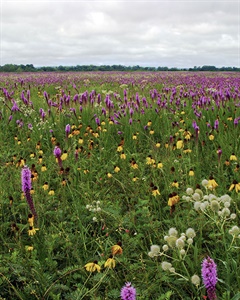I commonly see crayfish chimneys in three distinctive and interesting habitats in Arkansas: 1) flat, seasonally wet prairies, 2) flatwoods, and 3) seeps. All three of these habitats have a key feature in common: a naturally high water table, which is
a feature essential to burrowing crayfish.
Wet prairies and flatwoods are related communities – flatwoods can be thought of as the wooded cousins of the prairies. Both occur in flat places and are typically found on old, elevated stream and river terraces. These terraces are above modern-day
floodplains and get their water primarily (or in many cases entirely) from precipitation (vs. flooding of streams or groundwater). Because we have seasonal variation in precipitation, with a wet season in the winter and spring and a dry season in
the summer and fall, these precipitation-driven communities have a wet-dry (or hydro-xeric) yearly water cycle.
Both communities also have some sort of water barrier in the soil, generally a layer of dense clay or rock, that restricts water from soaking in beyond a foot or two. The hydrology of these ecosystems is similar to that of a flowerpot with no drain holes.
As you pour water in, eventually the soil becomes saturated, and if more water is added than the soil can hold, it will stand on the surface. This happens during the wet season when water often stands several inches deep in lower areas. As the season
progresses the plants begin to grow and suck up the water. By summer, the surface of the soil typically dries out, but it is still wet down below the surface. Anyone who has spent much time in these communities has probably gotten a vehicle stuck
up to the axles, deceived by the dry soil surface only to discover soft mud beneath.
If you’re a crayfish, who needs water to breathe, you can hang out on the surface during the wet season, but as the water table drops you have to dig down to keep wet. The drier it gets, the deeper you dig. The chimneys are the byproduct of this
digging, built up as mud is excavated and brought to the surface. The classic crayfish species of wet prairies and prairie flatwoods in Arkansas is the Osage Burrowing Crayfish (Procambarus liberorum), which is fairly widespread and locally common
in some areas, such as around Fayetteville and Rogers. Another, more restricted species in Arkansas is the Red River Burrowing Crayfish (Procambarus curdi), which is found in extensive (or formerly extensive) flatwoods in southwestern Arkansas.
Seeps have a different hydrology than wet prairies and flatwoods, but also have seasonally to permanently saturated soil. Like the name implies, seeps occur where groundwater naturally seeps up through the soil over a broad area. They are found in hilly
areas, where the water table meets the surface of the ground. This often occurs at the contact between a water-permeable soil or rock layer (like sand or sandstone) that overlies an impermeable layer (like clay or shale). Water moves downslope underground
through the permeable layer and emerges where the top of the impermeable layer comes to the surface. Seeps may also occur in areas associated with springs in karst (limestone) areas in the Ozarks.
Some seeps are wet all year, but others tend to dry out, at least around the edges, during periods of lower rainfall. In these areas you may find crayfish chimneys. Several rare and endemic species of crayfish are associated with seeps in the Coastal
Plain of Arkansas. One such species is the Jefferson County Crayfish (Creaserinus gilpini), which is known from just a handful of sites near Pine Bluff.
